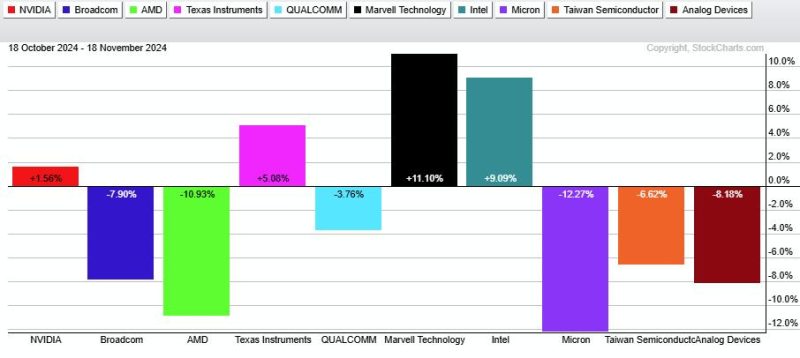In the fast-evolving world of technology, semiconductor companies play a crucial role in driving innovation and powering various electronic devices. Investors looking to gain exposure to this sector often turn to exchange-traded funds (ETFs) that focus on semiconductor stocks. One interesting comparison in this space is between the VanEck Vectors Semiconductor ETF (SMH) and the iShares PHLX Semiconductor ETF (SOXX).
Both SMH and SOXX are popular choices for investors seeking to invest in semiconductor companies. However, a closer look at the performance and composition of these two ETFs reveals that there are key differences that have influenced their respective performances in recent times.
**Performance Comparison**
Over the past few years, the semiconductor industry has been impacted by various factors such as trade tensions, global supply chain disruptions, and shifting demand patterns. Despite these challenges, SMH has managed to outperform SOXX in terms of returns.
One of the reasons behind SMH’s relatively better performance could be its equal-weighted approach compared to SOXX’s market-cap weighted strategy. By giving equal importance to each holding, SMH reduces concentration risk and ensures that smaller companies have a more significant impact on its performance.
Additionally, SMH’s portfolio includes a diverse range of semiconductor companies across various sub-sectors, which helps in spreading risk and capturing opportunities across multiple areas of the industry. In contrast, SOXX has a more concentrated portfolio, with a heavy tilt towards large-cap stocks, which can lead to higher sensitivity to market fluctuations.
**Composition Analysis**
Another factor contributing to SMH’s resilience could be its exposure to certain segments of the semiconductor industry that have fared better during challenging times. For instance, SMH has a higher allocation to companies involved in the production of memory chips, which have seen increased demand from sectors such as cloud computing, data centers, and artificial intelligence.
Furthermore, SMH’s holdings have a higher exposure to companies that offer diversified product portfolios, addressing multiple end markets and reducing dependency on specific customers or sectors. This diversification helps SMH navigate industry headwinds more effectively and capitalize on emerging opportunities.
On the other hand, SOXX’s portfolio composition might make it more vulnerable to adverse market conditions due to its focus on a few dominant players in the semiconductor industry. While these companies have strong market positions and robust financials, their performance can significantly impact SOXX’s overall returns.
**Conclusion**
In conclusion, the tale of two semiconductor ETFs – SMH and SOXX – highlights the importance of understanding the nuances of ETF composition and investment approach when making decisions in the technology sector. While both ETFs offer exposure to semiconductor companies, SMH’s equal-weighted structure, diversified holdings, and exposure to resilient sub-sectors have helped it hold up better compared to SOXX in recent times.
Investors looking to capitalize on the growth potential of the semiconductor industry should consider factors such as portfolio diversification, exposure to different sub-sectors, and investment strategy when selecting an ETF. By conducting thorough research and understanding the underlying dynamics of each ETF, investors can make informed decisions to align their investment objectives with the opportunities presented by the ever-evolving technology landscape.

























